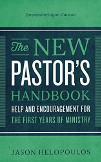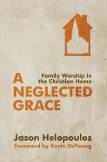
Jesus' Ark
As I have been preaching through the book of Genesis, I have been struck afresh by the Creation/New Creation structure of the entirety of Scripture--no less in its opening chapters. We have considered the various elements of new creation as we have gone from creation to the flood. Redemptive history so orders the revelation that if we don't emphasize the biblical-theological direction of any given passage in Genesis, what in the world do we have to preach to God's people? The faith of Noah? Well, who did Noah have faith in? The coming Redeemer, of course. The certain expectation of judgment? Yes. But judgment because of the rejection of God's way of salvation in Christ. The flood narrative is especially pregnant with redemptive history. It is a gold mine full of redemptive-historical nuggets. We often shorthand the flood narrative by speaking of "Noah's Ark" but I have come to believe that it might be better for us to speak of it as "Jesus' Ark." Consider the following redemptive-historical elements of the flood narrative:
1) The Redemptive Historical Role of Noah as a Type of Christ: Noah was a type of Christ. He was a typical second Adam, a typical Redeemer, and a typical rest giver. Noah was given very similar instructions as those given to Adam at creation with regard to being fruitful and multiplying, filling the earth and subduing it. He was a sort of "second Adam"--a type of the last Adam. Jesus is the last (eschatological) Adam who redeems His people and fulfills the creation mandates. Noah was a typical redeemer. Everyone with Noah on the Ark was saved. Everyone in Christ is saved. Noah was not “the Redeemer.” He was a typical redeemer, providing typical redemption for all those who descended from him. Jesus came to redeem all those He represented spiritually. Noah was a typical rest-giver. Noah’s name meant ‘Rest.’ His father had named him "Rest," saying, “This one will give us rest from the ground which the Lord had cursed.” Noah only gives typical rest, as the remainder of the Bible bears witness to the ongoing need for redemptive rest. Jesus is the One who finally and fully gives rest to the people of God and to the creation that was brought under the curse at the fall. He is the One who said, “Come unto Me and I will give you rest for your souls.” He is the One who takes the curse on Himself when He wears the crown of thorns–the symbol of the curse on the ground.
2) The Redemptive Historical Foreshadowing of the New Creation:
The Flood was essentially creation undone. The abating of the waters was essentially the re-creation of the world. It was essentially salvation through judgment. Because men had rejected God and His word, the Lord removed that word from upholding the world. Just as God had formed the world out of the waters, so He destroyed the world with the waters. Except for Noah and his family, all mankind had given themselves over to completely worshiping the creature rather than the Creator, and so, they were destroyed by what they worshiped. Sinclair Ferguson gives us a profound explanation of the "creation coming undone" aspect of the flood when he says:
The judgment fits the crime—the sin—perfectly…and the sin here is the heart rejection of the word of God and the judgment, interestingly, perfectly matches it—and, the narrative underlines this. If we can be sensitive to it for a moment and remember these opening chapters of Genesis you’ll notice that the description of what will happen to the heavens and the earth and to the created order uses the very language that is used in Genesis 1 and 2 to describe how the entire created order came into being. And so God is saying, ‘My powerful word has brought this world into being and keeps this word in place but you are rejecting My powerful word of warning and therefore I will remove it from you and this world will begin, as it were, to cave in on itself and disintegrate. And the very same phrases, the same language, the same verbs are used here as are used in Genesis 1 and 2. The judgment of the flood is actually a picture of creation going into disintegration. As though God had said, ‘If you will not listen to My word—and push it out of your life—then you will see what happens when you push my word out of your lives—and all of life collapses.’
The new creation aspect of the flood narrative is also seen it the waters abating and Noah and his descendants stepping off of the Ark with all living creatures to repopulate and fill the earth. Interestingly, the book of Revelation tells us that the “new heavens and the new earth” will be the eschatological Temple where God dwells fully and permanently with the redeemed. In it, the lion will lay down with the lamb. Noah and all of creation were together in the Ark, as in a typical temple. This was foreshadowing the new creation-temple. Interestingly, the Ark and Solomon’s Temple had three levels. The Ark looked more like a house than a boat. It had a roof, a window and a door. It seems that the biblical data substantiates that the Ark was a Temple where God dwelt with His creation. Noah also lead the way into a typical new creation when he and his family stepped off of the Ark and into a world that has been typically cleansed of pollution. Jesus brought about the new creation through His death and resurrection. Jesus' body was the Temple in which God fully dwelt. Noah knew that the flood had not made “all things new” because he sacrificed when he stepped off of the Ark. The flood waters could never cleanse the evil out of the heart of man. God had destroyed the earth with a flood because “every intent of the thoughts of man’s heart was only evil continually” (Gen. 6:5). God promised never to destroy the earth with a flood again because “the imagination of man’s heart is evil from his youth” (Gen. 8:21). The reason for the latter declaration was that the flood was never meant to deal with man’s real problem–the sinful pollution of his heart. Noah’s sons would populate the earth with depraved sinners. Only the blood of Jesus could cleanse the hearts of sinners. The judgment that fell on Him at the cross is the source of our salvation. The cleansed world onto which Noah and his family stepped when the waters receded was a type of the “new heavens and the new earth in which righteousness dwells” that was purchased and secured by Jesus' death and resurrection.
3) The Redemptive Historical Purpose of the Animals: Noah was commanded to take seven clean and two unclean of every animal into the Ark (Gen. 7:2). The clean/unclean distinction was relevant in redemptive history for several reasons. First, it would be used in Israel’s sacrificial system. Because Jesus is likened to “a Lamb without blemish and without spot,” Israel would be commanded in the OT to offer spotless (clean) lambs to God. All of Israel’s sacrifices were to be clean. The cleanness was symbolic of the sinlessness of Jesus. When he stepped off of the Ark, the very first thing that Noah did was offer a sacrifice to God. The sacrificial system stretched back to Adam and Eve and was carried forward in redemptive history until Christ was sacrificed. In addition to the preparation for the sacrificial system in Israel, the clean and unclean animals would, in time, become illustrative of the two groups of mankind–Jews and Gentiles. These two classifications represented spiritually clean and unclean groups of humanity in redemptive history until Christ came. The Scriptures expressly teach this in the account of Peter’s vision of the unclean animals brought down from heaven in the sheet for him to eat. (Acts 10:9-11:18). For a more thorough treatment see this post. The final thing to note about the animals in the Ark is in regard to food. Before the flood it appears that man was only permitted to eat vegetation. After the flood, God told Noah that he and his descendants could eat meat (only without the blood). What was the reason for this shift? The eating of meat would not serve as a precursor to the eating of the sacramental and ceremonial redemptive meals, such as the Passover. There were no vegetarians in the Old Covenant church because God was foreshadowing the spiritual eating of the flesh and blood of His Son in the sacrifices. If man had not been allowed to eat meat, then the eating of the sacrificial meals–symbolizing the spiritual eating of the flesh of the Son of God by faith–would have been an unintelligible concept. God was preparing His people for what would come as the history of redemption unfolded.
4) The Redemptive Historical preservation of the Redeemer. Sinclair Ferguson has helpfully explained this principle by saying, "No Noah, no Jesus." If Noah had not been saved on the Ark, then the promise of Genesis 3:15 would have failed and the Redeemer would not have come into the world to save a people out of every tongue, tribe, nation and language. God was most certainly saving creation and mankind in the Ark for the purpose of redemption, but He was also saving the Redeemer in the Ark for the purpose of redemption. The human nature of Jesus was, as it were, in the loins of Noah. This is a point of no small significance. Noah was not destroyed by the floodwaters, in part, because the human nature of the Redeemer had to be preserved in the Ark in Noah so that one day it would be destroyed in the judgment that fell on Jesus at the cross.
Christward Collective is a conversation of the Alliance of Confessing Evangelicals. It is supported only by its readers and gracious Christians like you. Please prayerfully consider supporting Christward Collective and the mission of the Alliance.



















 © Alliance of Confessing Evangelicals
© Alliance of Confessing Evangelicals


